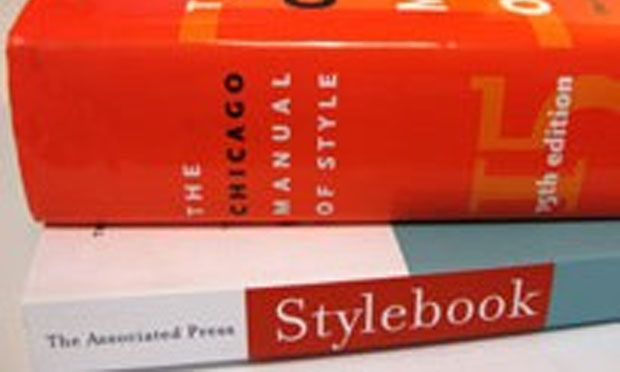The writing term style refers to a set of rules that help ensure that your stories are as clear, consistent and understandable as possible. There are a number of style guides available for journalists, the two most prominent of which are The Associated Press Stylebook and The Chicago Manual of Style.
AP style was established over time by the Associated Press, which was founded more than 150 years ago, and is updated regularly. Chicago style was created by the University of Chicago Press and is currently in its 15th edition. Along with these general-purpose style guides, many publications have in-house style guides, such as The New York Times Manual of Style and Usage.
While all style guides have the same goal, the specifics are often different. This can include how commas are used in certain situations (AP style suggests “red, white and blue,” while Chicago recommends “red, white, and blue”) or how the names of publications are treated (AP prefers “the” capitalized and no italics — The Boston Globe — and Chicago prefers a lowercase “the” with the name in italics — the Boston Globe). AP tries to be a dictionary as well, while Chicago defers to Webster’s.
While such distinctions might seem minor, they can spark fierce arguments among writers and readers. Readers may be less concerned with specific choices, but inconsistencies, however small, can undermine their confidence in your writing.
The reason for the differences stem from the organizations’ histories and target audiences. AP style is designed to address the challenges of the organization’s large size and readership: it had to be easy for reporters and editors to use in producing stories that are clear and concise. The guide itself is intentionally short and focused; subtleties are bypassed in the interest of brevity. Many stylistic decisions — for example, the resolute absence of italics, accents on non-English names and extended characters such as en-dashes — reflect technical limitations from the hot-type era that have persisted. These simplifications make consistency easier to achieve, if at the occasional price of clarity.
Chicago style reflects its book-publishing heritage, stressing completeness over compactness. While the most recent edition of AP is 420 pages, Chicago has more than twice as many pages with much more dense type. The end result of all those additional pages and content is more guidelines, examples and authority. And unlike AP, Chicago style reflects the current state of the art in typography — accents and italics are embraced, for example.
AP style and in-house variants are used by many U.S. newspapers as well as online news sites such as Politico.com and The Huffington Post. Chicago style is found most often in major periodicals, journals and book publishers. Sites such as Slate, ProPublica and The Daily Beast have styles somewhere in between the two. Which style you use is a matter of choice; what is important is that your readers understand you, and a central part of that is consistency throughout everything you write, from a brief item to a lengthy feature.
Keywords: capitalization, punctuation, copyediting, AP style, Chicago Style


Expert Commentary